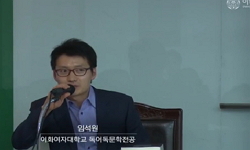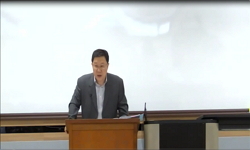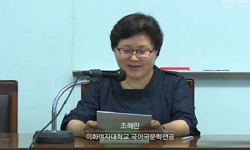거쳤던 박영원(朴永元, 1791~1854)이 4대에 걸쳐 임금과 세자를 가르친 내용을모아놓은 <강의(講義)>의 분석을 통해 당시 제왕 교육의 내면을 고찰할 목적으로 시도되었다. 박영원은 각기 ...
http://chineseinput.net/에서 pinyin(병음)방식으로 중국어를 변환할 수 있습니다.
변환된 중국어를 복사하여 사용하시면 됩니다.
- 中文 을 입력하시려면 zhongwen을 입력하시고 space를누르시면됩니다.
- 北京 을 입력하시려면 beijing을 입력하시고 space를 누르시면 됩니다.
군신(君臣)과 사제(師弟)의 경계에서 : 오서유고(梧墅遺稿) 소재 <강의(講義)>를 통해 본 19세기 제왕 교육의 내면 = On the Border of Lord-Vassal and Teacher-student Relations
한글로보기https://www.riss.kr/link?id=A75224325
-
저자
이은영 (이화여대 국어국문학과)
- 발행기관
- 학술지명
- 권호사항
-
발행연도
2007
-
작성언어
Korean
-
주제어
박영원 ; 오서유고 ; 19세기 ; 경연 ; 서연 ; 효명세자 ; 순조 ; 헌종 ; 철종 ; 성학 ; Young-Won Park ; Oseyuko ; 19th Century ; Prince Hyomyeng ; King Sunjo and King Henjong ; King Cheljong ; lord-vassal ; teacher-student
-
KDC
380.000
-
자료형태
학술저널
- 발행기관 URL
-
수록면
131-164(34쪽)
-
KCI 피인용횟수
3
- 제공처
- 소장기관
- ※ 대학의 dCollection(지식정보 디지털 유통체계)을 통하여 작성된 목록정보입니다.
-
0
상세조회 -
0
다운로드
부가정보
국문 초록 (Abstract)
거쳤던 박영원(朴永元, 1791~1854)이 4대에 걸쳐 임금과 세자를 가르친 내용을모아놓은 <강의(講義)>의 분석을 통해 당시 제왕 교육의 내면을 고찰할 목적으로 시도되었다. 박영원은 각기 다른 조건에 놓여 있었던 네 명의 군왕과 세자를 차별화된 방식으로 가르쳤다. 미래의 군왕으로서 세자 수업을 받고 있었던 효명세자에게는 세자의 위치에서 절실한 문제인 학문에 체계적으로 접근하도록 유도하였고, 군왕으로서의 책무를 다해야 하는 순조와 헌종에게는 다양한 문제로 입체적인 생각을 끌어내면서 사고의 깊이를 추구하도록 하였다. 또한 지적인 면에서나 정서적인 면에서 준비가 안 된 상태로 등극한 철종에게는 문답 방식을 적극적으로 활용, 적극적인 참여를 유도하면서 문제 해결의 방법을 모색해 보도록 하는 강의방식을 구사하였다. 박영원이 <강의>를 남긴 목적은 성학(聖學)에 대한 위기의식이었다. 당시는 준비되지 않은 왕들이 잇따라 등극하면서 수렴청정(垂簾聽政), 세도정치(勢道政治) 와 같은 비정상정인 정치 행태가 나타나고 있던 시기이다. 이러한 때 군왕의 스승으로 살았던 박영원은 위기의 중심에서 문제를 해결할 수 있는 주체는 군왕이라고 생각하였고 성학(聖學)의 진작과 왕도정치(王道政治)의 달성만이 난국 타결의 유일한 해결책이라고 믿었다. <강의>는 박영원의 이러한 고뇌와 소명 의식이 잘 드러나는 글이다. 그 속에는 실권 없이 왕위를 지켜야 하는 제자에 대한스승으로서의 안타까움과 왕도 정치의 주체로서 우뚝 서기를 바라는 신하로서의 강력한 요구가 동시에 드러나 있다. 체계성과 깊이가 돋보이면서도 인간적 정감 역시 배제되지 않고 있는 <강의>의 서술 방식은 군신(君臣)과 사제(師弟) 의 경계에서 살아야 했던 한 국가 원로의 내면을 보여준다.
다국어 초록 (Multilingual Abstract)
This paper analyzes “Kanguy” which contains the lectures and teachings byYoung-Won Park who went through key positions at the age of so-calledSedojengchi (Authority politics) in the 19th century, and taught the kings andprinces during four success...
This paper analyzes “Kanguy” which contains the lectures and teachings byYoung-Won Park who went through key positions at the age of so-calledSedojengchi (Authority politics) in the 19th century, and taught the kings andprinces during four successive reigns, with a view to investigating the inside ofthe contemporary education of monarchs.
Young-Won Park instructed four kings and princes in a differentiated mannertailored to each of their conditions. He guided Prince Hyomyeng, who would bea future king, to approach ‘learning’, which is an urgent requirement for thecrown princes, in a systematic way, and provided King Sunjo and KingHenjong, who must take responsibilities as sovereign, with diverse problems sothat they could think of them from various angles in pursuit of in-depththinking. As for King Cheljong who was enthroned at an inadequate state ofintelligence and emotion, Park positively employed a question-and-answer formin order for the king to take an active part in seeking solutions to the givenproblems.
The purpose for Park’s recording “Kanguy” is a sense of crisis for Senghak(Learning of sovereigns, sage kings, in particular). In those times, such abnormalgovernments as Sulyemchengceng (Regency by the queen mother) or Sedojengchi (Authority politics) were executed due to the successive enthronements of theunprepared kings. Under such circumstances, Park, as teacher to the kings,believed that the king was the subject who could solve the problems in thecenter of crisis, and only the promotion of Senghak and achievement of royalstatesmanship is the sole solution to breaking the deadlock. “Kanguy” assuredlyreflects this anguish and sense of calling of Park’s. It shows not only themaster’s frustration for the disciple who must hold the kingship without actualpower, but also the vassal’s forceful request for the king to stand high as thesubject of royal government. The method of narration for “Kanguy” isprominent in its systemicity and depth on the one hand, and it does notexclude human sentiment on the other. Therefore, it reveals the inner world ofa senior statesman who had to live on the relational border of lord-vassal andteacher-student.
목차 (Table of Contents)
- Ⅰ. 들어가는 말
- Ⅱ. <강의>의 구성과 내용
- Ⅲ. <강의>의 서술방식과 특징
- 1. 주제집중식 교수방식과 <강의>의 ‘체계성’:효명세자의 경우
- 2. 문제제기식 교수방식과 <강의>의 ‘깊이’:순조, 헌종의 경우
- Ⅰ. 들어가는 말
- Ⅱ. <강의>의 구성과 내용
- Ⅲ. <강의>의 서술방식과 특징
- 1. 주제집중식 교수방식과 <강의>의 ‘체계성’:효명세자의 경우
- 2. 문제제기식 교수방식과 <강의>의 ‘깊이’:순조, 헌종의 경우
- 3. 문답식 교수방식과 <강의>의 ‘정감(情感)’:철종의 경우
- Ⅳ. <강의>의 집필 의도와 의의
- Ⅴ. 나오는 말
- 참고문헌
- Abstract
동일학술지(권/호) 다른 논문
-
- 이화여자대학교 한국문화연구원
- 박철상
- 2007
-
- 이화여자대학교 한국문화연구원
- 홍선표
- 2007
-
- 이화여자대학교 한국문화연구원
- 김문식
- 2007
-
- 이화여자대학교 한국문화연구원
- 서정민
- 2007
분석정보
인용정보 인용지수 설명보기
학술지 이력
| 연월일 | 이력구분 | 이력상세 | 등재구분 |
|---|---|---|---|
| 2027 | 평가예정 | 재인증평가 신청대상 (재인증) | |
| 2021-01-01 | 평가 | 등재학술지 유지 (재인증) |  |
| 2018-01-01 | 평가 | 등재학술지 유지 (등재유지) |  |
| 2016-02-15 | 학술지명변경 | 외국어명 : 미등록 -> The Korean Cultural Studies |  |
| 2015-01-01 | 평가 | 등재학술지 선정 (계속평가) |  |
| 2013-01-01 | 평가 | 등재후보학술지 유지 (기타) |  |
| 2012-01-01 | 평가 | 등재후보학술지 유지 (기타) |  |
| 2011-01-01 | 평가 | 등재후보 1차 FAIL (등재후보2차) |  |
| 2010-01-01 | 평가 | 등재후보 1차 PASS (등재후보1차) |  |
| 2009-06-11 | 학회명변경 | 영문명 : Korea Cultural Research Institute -> Korea Culture Research Institute |  |
| 2008-01-01 | 평가 | 등재후보학술지 선정 (신규평가) |  |
학술지 인용정보
| 기준연도 | WOS-KCI 통합IF(2년) | KCIF(2년) | KCIF(3년) |
|---|---|---|---|
| 2016 | 0.44 | 0.44 | 0.4 |
| KCIF(4년) | KCIF(5년) | 중심성지수(3년) | 즉시성지수 |
| 0.44 | 0.4 | 0.735 | 0 |




 RISS
RISS KISS
KISS







